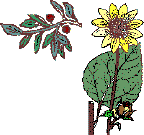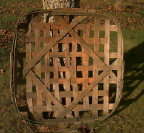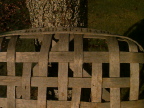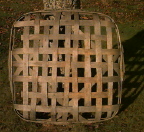
Winter | Spring | Summer | Fall | Holiday
Baskets | Community
Herbs and Baskets
baskets



Traditional North Carolina Tobacco Basket
We realize that tobacco is a controversial subject. We are not promoting the use of tobacco here, merely reporting on a type of basket which is fast disappearing and one which is an important part of history in North Carolina.
If, after reading the history and seeing the directions, you think that this would be a handy basket to use, you could just as easily call it a warehouse basket or a type of market basket. It is known throughout this region as a tobacco basket.
The tobacco basket was used, until about 1980, to display tobacco taken to market. The crop is grown throughout North Carolina, primarily on family farms. According to the NC Dept. of Agriculture, North Carolina farmers today produce approximately 2/3 of the US crop of flue-cured tobacco.
Tobacco is a very labor-intensive crop. The leaves are picked by hand, starting at the bottom of the stalk. In the old days, the leaves were then carried to the tobacco barn where they were hand-tied onto to sticks about 3 feet long. The sticks were then placed in tiers in the tobacco barn. A fire was lit and the leaves were cured to a rich golden color in the barn.
When the sticks were removed from the barn, the leaves were then sorted by size and original location on the stalk of tobacco. Tips are from the top of the plant; cutters, about half as long as your arm, are from the center of the stalk; lugs are from the bottom. There are 216 different grades of tobacco.
After sorting and grading, the leaves were tied into "hands." A hand of tobacco weighed about 1 pound if made of tips or lugs and about 2 - 3 pounds if made from cutters. A hand of tobacco is a group of leaves tied together at the stem end. The end is wrapped in another cured leaf.
The hands were then laid in the tobacco basket in a circle with the stem ends pointing to the outside. The baskets were then loaded and taken to the tobacco warehouse where they were sold at auction. The song of the tobacco auction is another story altogether.
At the warehouse, the baskets would be stacked about two high to reach a pile weight of 250 pounds of flue-cured tobacco.
The baskets were made from hand-rived oak, primarily in Yadkin County. The oak strips are nailed together. The open spaces in the center of each side are to allow room for a hook to be attached. The hook was used to pull the baskets onto the scales and to load the baskets into trucks after the sale.
The baskets were owned by the warehouse or the Board of Trade, a consortium of tobacco companies. The company name was stencilled onto the edge of the basket.
Baskets are no longer used in the warehouses of North Carolina. They have been replaced by burlap sheets. Baskets are still used in the markets in Maryland.
You are now more likely to encounter a tobacco basket in an antique store or see one hung on chimney as a decorative device. Some baskets are hung on walls inside homes and used to display memorabilia or flower arrangements or other decorative items.
Related article:
The information about the tobacco basket was graciously provided by John Holt, a tobacconist and shipping supervisor for a tobacco company. John is also well known for his talents in telling North Carolina ghost stories.
prev next
|
Site design, and webmastery by Cicada Consulting Group
Copyright © In Season Herbs and Basketsc 1997 All rights reserved. |
Page refreshed: Sat, Feb 23, 2002
http://www.inseason.com/baskets/tobaccobasket.html |